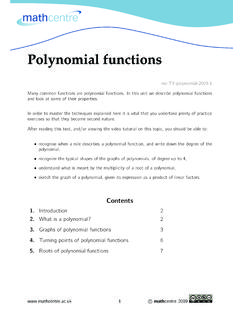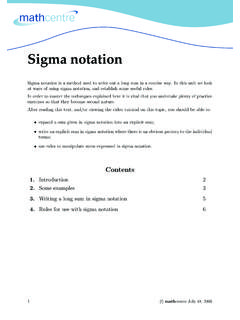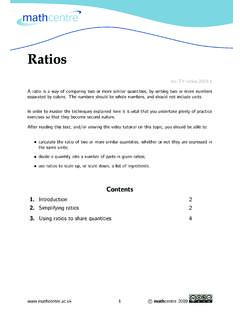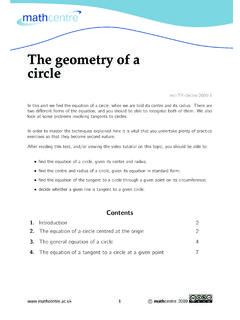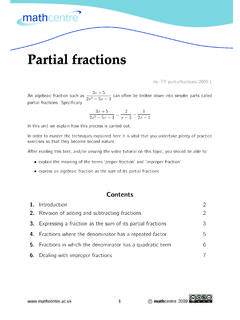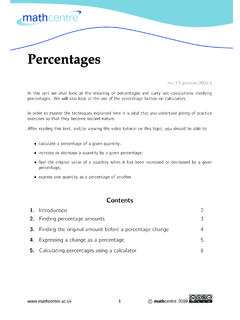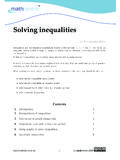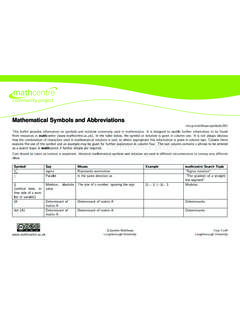Transcription of Cubic equations - mathcentre.ac.uk
1 Cubic equations mc-TY-cubicequations-2009-1. A Cubic equation has the form ax3 + bx2 + cx + d = 0 where a 6= 0. All Cubic equations have either one real root, or three real roots. In this unit we explore why this is so. Then we look at how Cubic equations can be solved by spotting factors and using a method called synthetic division. Finally we will see how graphs can help us locate solutions. In order to master the techniques explained here it is vital that you undertake plenty of practice exercises so that they become second nature. After reading this text, and/or viewing the video tutorial on this topic, you should be able to: explain why Cubic equations possess either one real root or three real roots use synthetic division to locate roots when one root is known find approximate solutions by drawing a graph Contents 1.
2 Introduction 2. 2. Cubic equations and the nature of their roots 2. 3. Solving Cubic equations 5. 4. Using graphs to solve Cubic equations 10. 1 c mathcentre 2009. 1. Introduction In this unit we explain what is meant by a Cubic equation and how such an equation can be solved. The general strategy for solving a Cubic equation is to reduce it to a quadratic equation, and then solve the quadratic by the usual means, either by factorising or using the formula. 2. Cubic equations and the nature of their roots A Cubic equation has the form ax3 + bx2 + cx + d = 0. It must have the term in x3 or it would not be Cubic (and so a 6= 0), but any or all of b, c and d can be zero.
3 For instance, x3 6x2 + 11x 6 = 0, 4x3 + 57 = 0, x3 + 9x = 0. are all Cubic equations . Just as a quadratic equation may have two real roots, so a Cubic equation has possibly three. But unlike a quadratic equation which may have no real solution, a Cubic equation always has at least one real root. We will see why this is the case later. If a Cubic does have three roots, two or even all three of them may be repeated. This gives us four possibilities which are illustrated in the following examples. Example Suppose we wish to solve the equation x3 6x2 + 11x 6 = 0. This equation can be factorised to give (x 1)(x 2)(x 3) = 0.
4 This equation has three real roots, all different - the solutions are x = 1, x = 2 and x = 3. In Figure 1 we show the graph of y = x3 6x2 + 11x 6. y 3. 2. 1. -1 1 2 3 x -1. -2. -3. Figure 1. The graph of y = x3 6x2 + 11x 6. Notice that it starts low down on the left, because as x gets large and negative so does x3 and it finishes higher to the right because as x gets large and positive so does x3 . The curve crosses the x-axis three times, once where x = 1, once where x = 2 and once where x = 3. This gives us our three separate solutions. 2 c mathcentre 2009. Example Suppose we wish to solve the equation x3 5x2 + 8x 4 = 0.
5 This equation can be factorised to give (x 1)(x 2)2 = 0. In this case we do have three real roots but two of them are the same because of the term (x 2)2 . So we only have two distinct solutions. Figure 2 shows a graph of y = x3 5x2 + 8x 4. y 3. 2. 1. -1 1 2 3 x -1. -2. -3. Figure 2. The graph of y = x3 5x2 + 8x 4. Again the curve starts low to the left and goes high to the right. It crosses the x-axis once and then just touches it at x = 2. So we have our two roots x = 1 and x = 2. Example Suppose we wish to solve the equation x3 3x2 + 3x 1 = 0. This equation can be factorised to give (x 1)3 = 0.
6 So although there are three factors, they are all the same and we only have a single solution x = 1. The corresponding curve is y = x3 3x2 + 3x 1 and is shown in Figure 3. y 3. 2. 1. -1 1 2 3 x -1. -2. -3. Figure 3. The graph of y = x3 3x2 + 3x 1. 3 c mathcentre 2009. As with all the cubics we have seen so far, it starts low down on the left and goes high up to the right. Notice that the curve does cross the x-axis at the point x = 1 but the x-axis is also a tangent to the curve at this point. This is indicative of the fact that there are three repeated roots. Example Suppose we wish to solve the equation x3 + x2 + x 3 = 0.
7 This equation can be factorised to give (x 1)(x2 + 2x + 3) = 0. The quadratic x2 + 2x + 3 = 0 has no real solutions, so the only solution to the Cubic equation is obtained by putting x 1 = 0, giving the single real solution x = 1. The graph y = x3 + x2 + x 3 is shown in Figure 4. y 3. 2. 1. -2 -1 1 2 3 x -1. -2. -3. -4. Figure 4. The graph of y = x3 + x2 + x 3. You can see that the graph crosses the x-axis in one place only. From these graphs you can see why a Cubic equation always has at least one real root. The graph either starts large and negative and finishes large and positive (when the coefficient of x3.)
8 Is positive), or it will start large and positive and finish off large and negative (when the coefficient of x3 is negative). The graph of a Cubic must cross the x-axis at least once giving you at least one real root. So, any problem you get that involves solving a Cubic equation will have a real solution. Exercise 1. Determine the real roots of the following Cubic equations - if a root is repeated say how many times. a) (x + 1)(x 2)(x 3) = 0 b) (x + 1)(x2 12x + 20) = 0 c) (x 3)2 (x + 4) = 0. d) (x + 2)(x2 + 6x + 10) = 0 e) (x + 2)(x2 + 7x + 10) = 0 f) (x 5)(x2 10x + 25) = 0. 4 c mathcentre 2009.
9 3. Solving Cubic equations Now let us move on to the solution of Cubic equations . Like a quadratic, a Cubic should always be re-arranged into its standard form, in this case ax3 + bx2 + cx + d = 0. The equation 6. x2 + 4x 1 =. x is a Cubic , though it is not written in the standard form. We need to multiply through by x, giving us x3 + 4x2 x = 6. and then we subtract 6 from both sides, giving us x3 + 4x2 x 6 = 0. This is now in the standard form When solving cubics it helps if you know one root to start with. Example Suppose we wish to solve x3 5x2 2x + 24 = 0. given that x = 2 is a solution.
10 There is a theorem called the Factor Theorem which we do not prove here. It states that if x = 2 is a solution of this equation, then x + 2 is a factor of this whole expression. This means that x3 5x2 2x + 24 = 0 can be written in the form (x + 2)(x2 + ax + b) = 0. where a and b are numbers. Our task now is to find a and b, and we do this by a process called synthetic division. This involves looking at the coefficients of the original Cubic equation, which are 1, 5, 2 and 24. These are written down in the first row of a table, the starting layout for which is 1 5 2 24 x = 2. 1. Notice that to the right of the vertical line we write down the known root x = 2.
